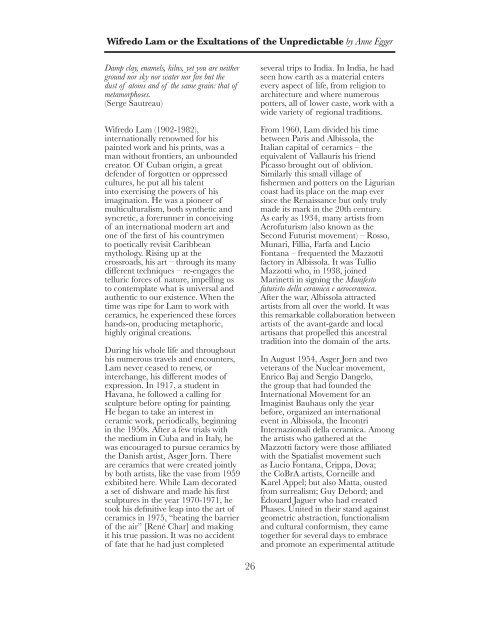Anne Egger – Wifredo Lam or the Exultations of the Unpredictable
Excerpt from the catalogue “Wifredo Lam – Fire Tongues: Ceramics”, published by Galerie Gmurzynska on the occasion of an exhibition at the gallery spaces in St. Moritz and Zug.
Excerpt from the catalogue “Wifredo Lam – Fire Tongues: Ceramics”, published by Galerie Gmurzynska on the occasion of an exhibition at the gallery spaces in St. Moritz and Zug.
You also want an ePaper? Increase the reach of your titles
YUMPU automatically turns print PDFs into web optimized ePapers that Google loves.
Wifredo <strong>Lam</strong> <strong>or</strong> <strong>the</strong> <strong>Exultations</strong> <strong>of</strong> <strong>the</strong> <strong>Unpredictable</strong> by <strong>Anne</strong> <strong>Egger</strong><br />
Damp clay, enamels, kilns, yet you are nei<strong>the</strong>r<br />
ground n<strong>or</strong> sky n<strong>or</strong> water n<strong>or</strong> fire but <strong>the</strong><br />
dust <strong>of</strong> atoms and <strong>of</strong> <strong>the</strong> same grain: that <strong>of</strong><br />
metam<strong>or</strong>phoses.<br />
(Serge Sautreau)<br />
Wifredo <strong>Lam</strong> (1902-1982),<br />
internationally renowned f<strong>or</strong> his<br />
painted w<strong>or</strong>k and his prints, was a<br />
man without frontiers, an unbounded<br />
creat<strong>or</strong>. Of Cuban <strong>or</strong>igin, a great<br />
defender <strong>of</strong> f<strong>or</strong>gotten <strong>or</strong> oppressed<br />
cultures, he put all his talent<br />
into exercising <strong>the</strong> powers <strong>of</strong> his<br />
imagination. He was a pioneer <strong>of</strong><br />
multiculturalism, both syn<strong>the</strong>tic and<br />
syncretic, a f<strong>or</strong>erunner in conceiving<br />
<strong>of</strong> an international modern art and<br />
one <strong>of</strong> <strong>the</strong> first <strong>of</strong> his countrymen<br />
to poetically revisit Caribbean<br />
mythology. Rising up at <strong>the</strong><br />
crossroads, his art – through its many<br />
different techniques – re-engages <strong>the</strong><br />
telluric f<strong>or</strong>ces <strong>of</strong> nature, impelling us<br />
to contemplate what is universal and<br />
au<strong>the</strong>ntic to our existence. When <strong>the</strong><br />
time was ripe f<strong>or</strong> <strong>Lam</strong> to w<strong>or</strong>k with<br />
ceramics, he experienced <strong>the</strong>se f<strong>or</strong>ces<br />
hands-on, producing metaph<strong>or</strong>ic,<br />
highly <strong>or</strong>iginal creations.<br />
During his whole life and throughout<br />
his numerous travels and encounters,<br />
<strong>Lam</strong> never ceased to renew, <strong>or</strong><br />
interchange, his different modes <strong>of</strong><br />
expression. In 1917, a student in<br />
Havana, he followed a calling f<strong>or</strong><br />
sculpture bef<strong>or</strong>e opting f<strong>or</strong> painting.<br />
He began to take an interest in<br />
ceramic w<strong>or</strong>k, periodically, beginning<br />
in <strong>the</strong> 1950s. After a few trials with<br />
<strong>the</strong> medium in Cuba and in Italy, he<br />
was encouraged to pursue ceramics by<br />
<strong>the</strong> Danish artist, Asger J<strong>or</strong>n. There<br />
are ceramics that were created jointly<br />
by both artists, like <strong>the</strong> vase from 1959<br />
exhibited here. While <strong>Lam</strong> dec<strong>or</strong>ated<br />
a set <strong>of</strong> dishware and made his first<br />
sculptures in <strong>the</strong> year 1970-1971, he<br />
took his definitive leap into <strong>the</strong> art <strong>of</strong><br />
ceramics in 1975, “beating <strong>the</strong> barrier<br />
<strong>of</strong> <strong>the</strong> air” [René Char] and making<br />
it his true passion. It was no accident<br />
<strong>of</strong> fate that he had just completed<br />
several trips to India. In India, he had<br />
seen how earth as a material enters<br />
every aspect <strong>of</strong> life, from religion to<br />
architecture and where numerous<br />
potters, all <strong>of</strong> lower caste, w<strong>or</strong>k with a<br />
wide variety <strong>of</strong> regional traditions.<br />
From 1960, <strong>Lam</strong> divided his time<br />
between Paris and Albissola, <strong>the</strong><br />
Italian capital <strong>of</strong> ceramics – <strong>the</strong><br />
equivalent <strong>of</strong> Vallauris his friend<br />
Picasso brought out <strong>of</strong> oblivion.<br />
Similarly this small village <strong>of</strong><br />
fishermen and potters on <strong>the</strong> Ligurian<br />
coast had its place on <strong>the</strong> map ever<br />
since <strong>the</strong> Renaissance but only truly<br />
made its mark in <strong>the</strong> 20th century.<br />
As early as 1934, many artists from<br />
Aer<strong>of</strong>uturism (also known as <strong>the</strong><br />
Second Futurist movement) – Rosso,<br />
Munari, Fillia, Farfa and Lucio<br />
Fontana – frequented <strong>the</strong> Mazzotti<br />
fact<strong>or</strong>y in Albissola. It was Tullio<br />
Mazzotti who, in 1938, joined<br />
Marinetti in signing <strong>the</strong> Manifesto<br />
futuristo della ceramica e aeroceramica.<br />
After <strong>the</strong> war, Albissola attracted<br />
artists from all over <strong>the</strong> w<strong>or</strong>ld. It was<br />
this remarkable collab<strong>or</strong>ation between<br />
artists <strong>of</strong> <strong>the</strong> avant-garde and local<br />
artisans that propelled this ancestral<br />
tradition into <strong>the</strong> domain <strong>of</strong> <strong>the</strong> arts.<br />
In August 1954, Asger J<strong>or</strong>n and two<br />
veterans <strong>of</strong> <strong>the</strong> Nuclear movement,<br />
Enrico Baj and Sergio Dangelo,<br />
<strong>the</strong> group that had founded <strong>the</strong><br />
International Movement f<strong>or</strong> an<br />
Imaginist Bauhaus only <strong>the</strong> year<br />
bef<strong>or</strong>e, <strong>or</strong>ganized an international<br />
event in Albissola, <strong>the</strong> Incontri<br />
Internazionali della ceramica. Among<br />
<strong>the</strong> artists who ga<strong>the</strong>red at <strong>the</strong><br />
Mazzotti fact<strong>or</strong>y were those affiliated<br />
with <strong>the</strong> Spatialist movement such<br />
as Lucio Fontana, Crippa, Dova;<br />
<strong>the</strong> CoBrA artists, C<strong>or</strong>neille and<br />
Karel Appel; but also Matta, ousted<br />
from surrealism; Guy Deb<strong>or</strong>d; and<br />
Édouard Jaguer who had created<br />
Phases. United in <strong>the</strong>ir stand against<br />
geometric abstraction, functionalism<br />
and cultural conf<strong>or</strong>mism, <strong>the</strong>y came<br />
toge<strong>the</strong>r f<strong>or</strong> several days to embrace<br />
and promote an experimental attitude<br />
26
















